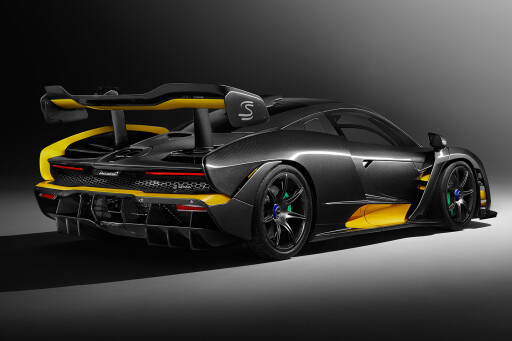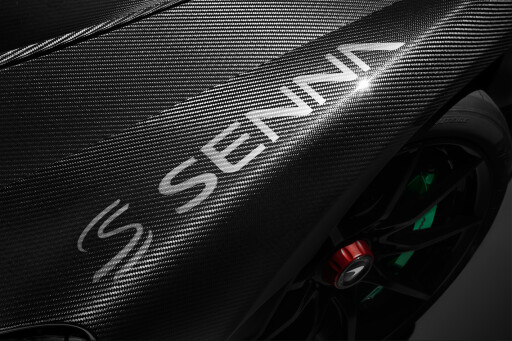
THOSE lucky enough to have secured one of 500 track-ready McLaren Sennas can now hand over the car to the brand’s McLaren Special Operations (MSO) unit to have some truly gobsmacking options fitted to the road-legal, track-focussed beast.
MSO has revealed the McLaren Senna, named for F1 legend Ayrton Senna, can be finished in what it calls a “Carbon Theme” that highlights the lightweight panels in a raw weave. Each of the 500 Sennas that McLaren will make will be hand-built, and owners who tick the box for MSO options can expect extra wait times before taking delivery of their car.
The yellow and green colour combo of the Carbon Theme is a not-so-subtle homage to Ayrton Senna’s iconic helmet design. Its 67 body pieces take 1000 hours to produce, while the yellow detailing alone takes 250 hours to apply.

The jaw-dropping looks won’t come cheap, either, with McLaren saying the option would add $A531,000 to the Senna’s $A1.3 million ‘base’ pricetag.
The Senna produces 588kW and 800Nm via a dry-sumped, flat plane crank “M840TR” 4.0-litre twin-turbo V8 – the most powerful combustion engine ever created by McLaren.
The MSO-fettled Senna Carbon Theme will be shown for the first time at next week’s Geneva Motor Show, sitting on McLaren’s stand alongside a ‘standard’ car.
But McLaren has also hinted at a surprise announcement for the show: likely to be confirmation of a GTE-spec Senna that will contest the 24 Hours of Le Mans.

Two major hints at the Senna’s potential racing conversion are the fact it is both road legal and slated to have a production run of 500 cars – enough volume to satisfy GTE homologation rules. Those are relatively high production numbers for what is, let’s face it, a track-focused special edition, and Ford did a similar thing with its reborn GT super car when it returned to Le Mans in 2016.
Class rules say GTE cars must be built from a road car base. However, some manufacturers get a little creative with their interpretation of the rules – here’s looking at you Porsche, with the mid-engined 911 RSR.
The road cars also must be produced in significant enough numbers to meet homologation requirements. The Automobile Club de l'Ouest (ACO), which hosts the 24 Hours of Le Mans and enforces GTE regulations alongside the Federation Internationale de l'Automobile (FIA) and World Endurance Championship (WEC), stipulates a minimum of 100 road cars built at a rate of one a week, with an official launch campaign and sales network. Again, there have been instances of rules being bent, with Ford’s GT road car entering production after the GTE race car had started competing in world championship events.
With 500 units planned, the Senna should easily meet class requirements. In contrast, the Aston Martin Vulcan hypercar would fall foul, though, because it isn’t street-legal and only 24 were built.

Engines in GTE are restricted in size to 5.5 litres when naturally aspirated, and 4.0 litres when boosted with turbo- or superchargers. The Senna’s M840TR, at 4.0 litres, falls right on the allowed capacity.
There are rare exemptions to these rules, with the BMW Z4 allowed to use an engine not found in the production car (but still made by BMW), and the Dodge Viper given a waiver to use the 8.0-litre V10 from the production car.
Then there is the Senna’s bodywork. It places traditional road car conventions in the bin, and is designed from nose to tail to be aerodynamically optimised. This gives the Senna an instant advantage over potential GTE rivals that start life with more conventional bodywork.
It would be a fitting return to endurance racing for McLaren. The McLaren F1 GTR famously beat purpose-built prototype sports cars to win the 1995 24 Hours of Le Mans – a massive triumph for a car that was never conceived with racetrack competition in mind.

A WEC rules remix is slated for 2020, which coincides with the 25th anniversary of the McLaren F1’s titanic victory.
With WEC’s LMP1 category struggling for entries (Toyota remains the only factory-backed team), the 2020 rules shake-up could move production-based vehicles to the top of the tree in terms of outright speed.
McLaren Automotive chief executive Mike Flewitt even went as far as to confirm the Woking group was looking at plans to develop a racing program for the Senna earlier this year. It can almost be guaranteed that the FIA, the WEC, and the ACO will be included in those discussions.
McLaren currently campaigns GT3 racing with the 650S, but has not built a GTE-spec car. A 720S GT3 is under development and due to make its race debut next year, but will remain ineligible to compete in the Le Mans endurance event.

COMMENTS